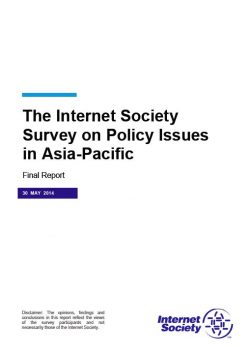Introduction
Developed by the Asia-Pacific (APAC) Regional Bureau, the Internet Society Survey on Policy Issues in Asia-Pacific is a crosssectional study of the attitudes of Internet Society (ISOC) members toward topical Internet policy concerns. Specifically, it seeks to gain insights on the importance of emerging and existing policy challenges as ranked by Internet users and stakeholders in the region. This report will provide an overview of the survey’s findings, which are intended to help the ISOC APAC Bureau better understand current perspectives on Internet policy in Asia-Pacific.
Background and methodology
The survey was conducted online using the Survey Monkey platform, and ran from January 20 to February 20, 2014. Unique individual invitations were sent via e-mail to 17,157 Internet Society members in Asia- Pacific as listed in ISOC’s membership database. As members and chapters are unevenly scattered across the region, this survey should not be construed as representative of the views of the general population of any particular geographic locality or of all countries in Asia-Pacific. The survey was administered in English and divided into five sections. The first consisted of questions that aimed to determine the demographic of the sample population; the second gathered information on respondents’ immediate policy environment; the third section asked respondents to rank regional policy issues to help the Bureau identify priority areas for stakeholder engagement; the fourth solicited perceptions on the APAC Bureau’s regional policy activities; and the fifth comprised of open questions that aimed to solicit important and emerging policy concerns that have not been covered by the previous sections.
The survey elicited responses from 1,800 participants, or 10.49% of the total sample population, and had a 99.8% completion rate. Close to half (48%) of the total number of respondents self-identified as residing in or originating from South Asia; 28% were from or in Southeast Asia, and the remaining 24% came from East Asia and the Pacific region.
Almost two-thirds of respondents (69%) were in the 25 to 45 age range. Many identified as belonging to either the technical community, the private sector or academia. Together, these three sectors comprised more than three-fourths (80%) of the total number of survey participants. The remaining 20% identified themselves most closely with government or civil society.
The majority of respondents are active Internet users, with 91% accessing the Internet at least once a day for various purposes—these activities range from information inquiries and email correspondence, to social networking, shopping and multimedia entertainment. An overwhelming majority (94%) likewise believed that they had ‘average’ or ‘above-average’ awareness of Internet-related issues in Asia-Pacific.
